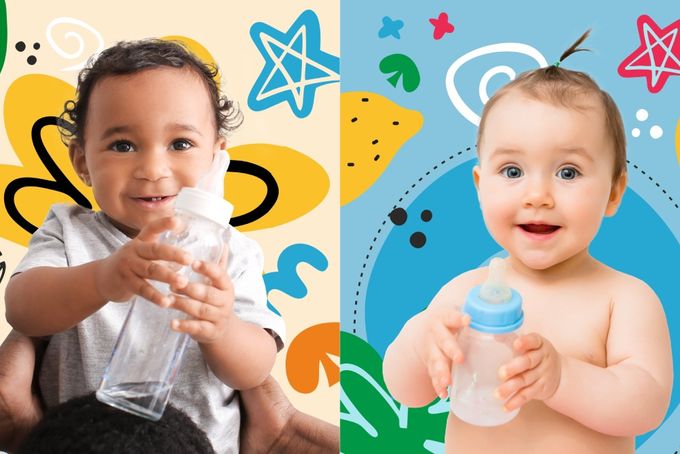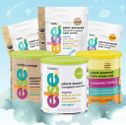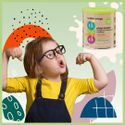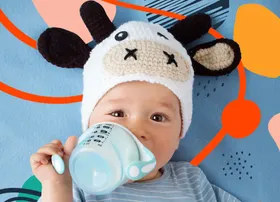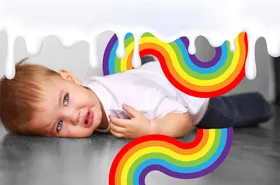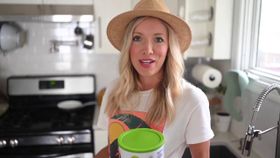How to Clean and Sterilize Baby Bottles for Your Child's Health
Explore the best practices and step-by-step instructions for cleaning and sterilizing baby bottles to keep your baby's feeding equipment germ-free and safe
Published August 12, 2024
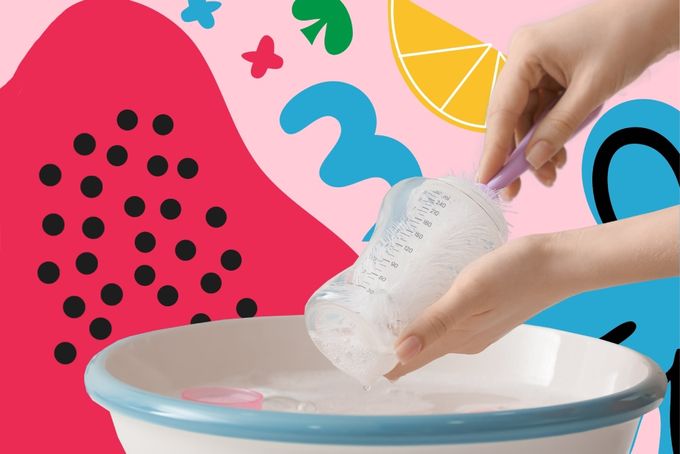
Adequate nutrition is one of the most crucial aspects of child-rearing. Everyone is aware of balanced nutrition, but do you know how essential it is to clean a baby bottle and how to do it properly?
Properly washing a baby bottle can destroy viruses. You'll need to pick an appropriate product from a store that sells home chemicals or utilize tried-and-true traditional treatments, as well as a washing instrument. This guide will explore the best practices for cleaning baby bottles, the importance of sterilization, and tips for choosing the right cleaning supplies.
» Discover healthy, plant-based nutrition—perfect for clean feeding and optimal growth!
Why is it important to clean and sterilize my baby’s bottles?
A little child's body is still learning to fight harmful microflora in the environment. Thus, one cannot do without the assistance of a mother in this instance. One of the most important jobs for moms during the breastfeeding stage is to serve the infant food that is both healthy and safe. It's easy to omit the required procedures for good handling because cleaning baby bottles might seem like an endless and dull task.
If you want to bottle-feed your baby, acquire a few extra bottles so that you have a sanitary set on hand throughout the day. When buying bottles, look at their appearance to see how to wash them in the coming years. The best choices are basic jars with no indentations, as indentations make it extremely difficult to remove the mixture's leftovers.
When purchasing plastic infant bottles, ensure that the material is devoid of the ingredient Bisphenol-A. Look for bottles that are labeled as BPA-free, as the ingestion of this compound can be harmful over time.
For more than 40 years, Bisphenol-A has been used to harden polymers. Medical supplies, CD players, dental sealants, water bottles, the lining of canned goods and beverages, and a variety of other products all include it. There are the following risks of having BPA in a baby bottle:
- It is known to be an endocrine disruptor, which means that it can disrupt normal hormone levels and maturation in fetuses, infants, and children.
- It may be involved in the development of certain cancers.
- The FDA's National Toxicology Program has raised concerns about its impacts on the brain and behavior of newborns and young children.
- Because infants' and young children's bodies are still forming, they are less effective at removing BPA from their circulation.
Dishes for youngsters should be washed separately from those for the rest of the household. Conventional products are ineffective because they have various risky ingredients. Organic liquid solutions disinfect the interior of the bottle and the teats effectively and securely. They don't contain any toxins and are produced using eco-friendly materials.
» Find out how to reduce your child’s exposure to toxins through diet
Dangers of improper baby bottle hygiene
When cleaning baby bottles, it’s important to consider the dangers of a non-disinfected bottle.
1. Failing to sterilize every bottle component
It's critical to clean all of the dismantled pieces of your baby bottle individually, including the bottle, ring, and pacifier. Milk can build up between the ring and the pacifier, stimulating bacterial growth. Regularly dismantling and cleaning these components is essential for ensuring your baby's safety.
2. Choosing unverified products without parental reviews
Selecting cleaning products without proper verification can be risky. Ensure they are free of harmful chemicals, scents, and artificial colors. Eco-labeled, hypoallergenic products are safer for baby bottles and offer effective disinfection without compromising health.
3. Overlooking the bottle's exterior
Pay attention to how thoroughly you wash the bottle's exterior. As long as the youngster holds it, their hands will contact the face and go inside the mouth. Keeping the exterior clean helps prevent the spread of germs.
4. Handling bottles with unwashed hands
Regular hand-washing is a good habit to develop in general and is especially important when handling baby products. Unwashed hands are a breeding ground for a variety of ailments. Always wash your hands thoroughly before and during bottle cleaning, as well as before feeding your baby, to minimize the risk of contamination.
What equipment needs cleaning, and how often?
Baby bottles need to be washed after every use. This ensures that any milk residue is removed, preventing the growth of bacteria. It's important to thoroughly clean and sterilize all components, including the bottle, ring, and pacifier, every time your baby finishes feeding.
How to properly wash a baby bottle
Don’t forget to wash your hands before cleaning the bottle. These are the obligatory steps to follow to know how to wash a baby bottle:
- After each use, immediately rinse the bottle so that milk will not remain on the bottle's sides.
- Detach the bottle and hand-wash each component individually.
- Before cleaning the bottle, it's a good idea to clean the sink to get rid of any chemicals. Scrub the sink with warm water and soap only before cleaning the bottle, as the sink still has many germs from the previous dishes.
- Fill your sink with hot, soapy water after rinsing it.
These steps may not be necessary for dishwasher-safe baby bottles.
However, if you prefer hand washing, you need to make sure the washing area is fully sanitized. Avoid using the sink for other tasks like washing buckets or bathing pets, as this can leave behind harmful germs. By keeping bottle cleaning separate from other tasks, you can significantly reduce the risk of contamination.
While this process may seem lengthy now, remember it’s only temporary and crucial for your baby’s health.
How to sterilize feeding equipment
There are several effective methods for sterilizing feeding equipment, such as using a dishwasher.
As for how often to sterilize baby bottles, consider the following guidelines: always sterilize new bottles before their first use, after washing with tap water, following any illness your child may have had, or if the bottles have been unused for an extended period.
- Sterilizing baby bottles in a dishwasher Place containers and accessories on the highest shelf of the machine and start the necessary mode if the instructions call for heat treatment at high temperatures.
- Sterilize baby bottles by boiling them The most cost-effective method of sterilizing antimicrobial cookware is boiling it. Choose a separate container to hold the needed quantity of dishes before sterilizing the bottles. Fill a pot halfway with water and set it on the burner to sterilize the bottles. Bring to a boil, then reduce heat to low for 3 to 10 minutes. Place on a dry, clean cloth and cover with a cotton towel after processing.
- Sterilize with steam in a multicooker Before beginning the sterilizing process in a multicooker, thoroughly clean the inside bowl. Fill it with roughly a liter of water. Place the steaming rack in the container. Bottles and accessories must be folded into the fitted grid. Set the "steam cooking" option and close the cover securely. Alternatively, manually set the timer for no more than 10 to 15 minutes.
- Get an electric sterilizer for baby bottles An electric sterilizer is a gadget that eliminates the need to choose a method of handling bottles. It's a convenient, small, and effective gadget that can accommodate 6 to 8 bottles. Fill a separate tank with cold water. Bottles should be standing straight with the neck down. Set the timer for 5-10 minutes on the sterilizer.
- Sterilize anywhere with sterilizing tablets Tablets for sterilizing baby dishes can be used anywhere that has water and a sterilization container. Dissolve the tablet in water and "push down" the bottles so that they are recessed in the container. The dishes will be sanitized for at least half an hour in this solution before being used. Be sure to follow the instructions on the tablet’s packaging.
- Opt for sterilization bags Bottle sterilization bags are a stand-alone method of disinfection. Pour 60 mL of water into the package for sterilization, then add a bottle, a nipple, and accessories before closing it with a "lock." The complete constructed set must be microwaved for 2 minutes and then cooled for the same amount of time. After that, remove the bag by contacting the section of it that has been labeled as safe by the manufacturer with your fingertips. The water must be drained via a particular hole before the clasp can be opened.
How to Sanitize a Baby Bottle
If you select chemical sanitizing over manual sanitizing, the detergent for children's dishes should be fully rinsed away with both hot and cold water.
- Bottles with a dispenser are available for BabyLine products. Natural food components are utilized to make this product. It has a strong antibacterial property.
- The brand Nuk's products are entirely made of biodegradable materials. Thanks to the activity of enzymes, they efficiently eliminate food detritus from baby dishes. It's a cost-effective solution that dissolves quickly in water and doesn't produce a lot of foam.
- The Pigeon product may be used to clean baby bottles and accessories from birth. The primary active components are sucrose ester and citric acid.
- Meine Liebe is designed to clean dishes for children aged one year and up, as well as toys and other household items. It easily eliminates oil and debris, foams up well, and washes off easily without drying out the skin on the hands.
While there’s not necessarily science behind these methods, below are some methods for cleaning that older generations have used in a pinch.
- Dry mustard is a great way to remove filth and oil from any surface, and it's also quite easy to clean.
- Sodium carbonate is another common alternative.
- Baby bottles can also be cleaned using laundry soap or a homemade detergent based on it.
- Lemon juice, in its purest form, imparts a pleasant scent to such items.
- Coarse salt is effective in washing fat away in cold water and dealing with the leftovers of fruit smoothies.
Finally, here are all the steps you need when it comes to how to wash a baby bottle:
- Make sure you have all of the cleaning tools you'll need.
- You’ll need a bottle brush to clean the bottom and sides of the bottle, as well as a rubber teat brush to remove germs from the teat.
- Fill your sink with hot, soapy water after rinsing it.
- Disassemble the bottle and hand-wash each component individually.
- Allow for complete drying of the bottle.
- Before feeding your infant, wash your hands.
Handwashing Vs. Dishwashing Baby Bottles
Let’s discuss some of the advantages and disadvantages of handwashing versus dishwasher-washing infant bottles.
| | Advantages | Disadvantages |
|---|---|---|
| Handwashing | You control what you wash. | - Detergents are very dry to the skin. - You need to watch for bacteria on your hands. - Sometimes, there is no time to wash. - Washing utensils harbor bacteria. |
| Dishwashing | Fast and convenient. | - Not everyone has a dishwasher. - Drainage water may leak into the nipple. - You cannot control what happens inside the mechanism. |
Do not wipe bottles and nipples after cleaning, sterilizing, or scorching. This makes it easy to pick up pathogens from the towel or leave paper towel fibers on them. Place wet bottles and nipples, ideally upside down, on a clean cotton cloth, or use a bottle and nipple drying rack to dry thoroughly.
Taking Control of Your Baby's Bottle Hygiene
It is entirely up to you to determine which approach to cleaning baby bottles is preferable. It may seem absurd, and we understand why: the parent can't keep track of how the child chews on everything in the home, licks the floor, and pulls everything into their mouth, and germs on the bottle are said to be harmful to the child's health. But one area in which you can control more of what germs your baby is exposed to is by practicing proper hygiene and washing their bottles and feeding supplies.
» Keep bottles clean & choose plant-based nutrition for a healthy start
FAQ
Do you need to sterilize water that is okay to drink?
The chance of a child becoming ill from water consumption is lower in areas where tap water is safe to drink than in areas where it is not. However, a newborn's immune system is quite weak during the first year of life, and water that is safe for an adult might be hazardous for a baby. Because infants' immune systems are significantly weaker than adults', more caution should be exercised while utilizing tap water.
Isn't it reasonable to enable youngsters to come into touch with microorganisms as early as possible?
By sterilizing feeding supplies, you protect your infant from bacteria and germs found in tap water, milk, and on your hands. Because even a tiny number of such germs can cause sickness in a young child, a newborn should be safeguarded against them from an early age as much as possible by using preventive tactics.
Is it true that sterilizing all food products kills beneficial microorganisms as well?
Sterilization will kill pretty much anything that lives on the utensil or bottle. But don’t worry; your child's food and their exposure to the environment will give all of the necessary healthy microbes for their developing immune system.
How do you feed your baby if you are going for a walk?
It's a good idea to have a couple of bottles ready ahead of time. Capped bottles can be stored in the refrigerator for six to eight hours. You may keep hot water in a thermos and the necessary amount of powder in a bottle, which you can combine right before feeding.
The content and advice provided in this article are for informational purposes only and are not a substitute for medical diagnosis, treatment, or advice for specific medical conditions. Always consult a pediatrician to understand the individual needs of your child.




